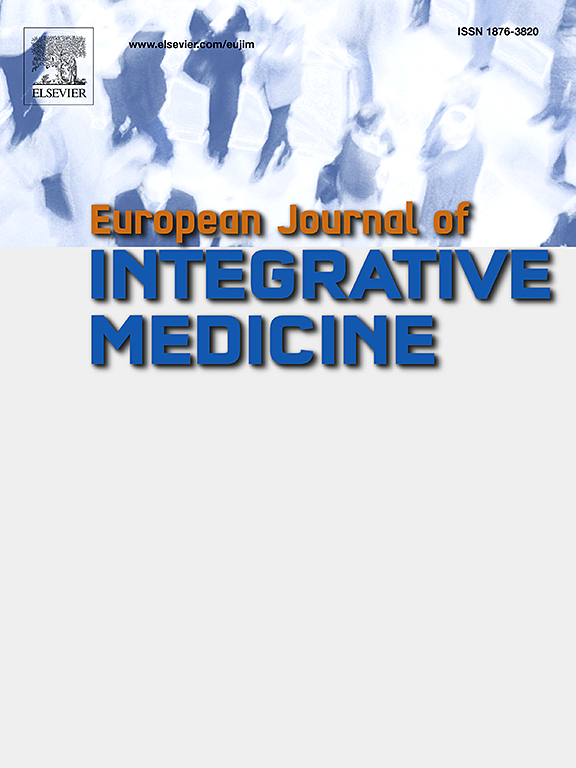Protective roles of genistein and icaritin in skin barrier integrity and hydration in an atopic dermatitis model
IF 1.7
4区 医学
Q3 INTEGRATIVE & COMPLEMENTARY MEDICINE
引用次数: 0
Abstract
Introduction
Atopic dermatitis (AD) is a common chronic skin condition that primarily affects children and is characterized by impaired skin barrier function. Factors such as immune dysregulation and filaggrin deficiency contribute to barrier dysfunction. This study investigates the protective effects of genistein and icaritin in an AD-like model, focusing on their impact on skin barrier integrity, hydration, tight junction stability, and antimicrobial peptide production.
Methods
Human epidermal keratinocytes (HaCat cells) were cultured in Dulbecco’s modified Eagle medium with 10 % FBS and 1 % penicillin-streptomycin at 37 °C in 5 % CO2 for 24 h. For the MTT assay, cells were plated at 1 × 10⁵ cells per well and treated with various concentrations of icaritin, genistein, their combinations, and dexamethasone. We established an AD-like inflammation model by treating the HaCat cells with TNF-α + IFN-γ (5 ng/ml), followed by extracting RNA and performing qRT-PCR using SYBR TOPreal, with GAPDH as the reference gene. The data are expressed as mean±S.D. (n = 3).
Results
Icaritin (6.25 and 12.5 μg/ml) and genistein (6.25 and 12.5 μg/ml) demonstrated no cytotoxic effects on HaCaT cells. Treatment significantly upregulated the expression of barrier-related genes, including filaggrin (FLG) with a fold change of 1.17 (genistein, 6.25 μg/ml, p < 0.01) and 1.16 (12.5 μg/ml, p < 0.05), Claudin-1 (0.75 (icaritin, 12.5 µg/ml, p < 0.001), and ZO-1 expression was significantly upregulated (1.79-fold) following combined treatment (p < 0.001). Furthermore, hyaluronic acid synthases (HAS-1, 1.66; HAS-2, 1.23) and hBD3 (1.98 at combined treatment) were notably increased.
Conclusion
Genistein and icaritin significantly enhance skin barrier integrity and hydration in HaCaT cells, upregulating key proteins including filaggrin and aquaporin 3, indicating their therapeutic potential in AD management.
染料木素和淫羊藿素对特应性皮炎模型皮肤屏障完整性和水化的保护作用
特应性皮炎(AD)是一种常见的慢性皮肤病,主要影响儿童,其特征是皮肤屏障功能受损。免疫失调和聚丝蛋白缺乏等因素可导致屏障功能障碍。本研究探讨了染料木素和羊藿苷在ad样模型中的保护作用,重点研究了它们对皮肤屏障完整性、水合作用、紧密连接稳定性和抗菌肽产生的影响。方法将人表皮角质形成细胞(HaCat细胞)在含有10% FBS和1%青霉素-链霉素的Dulbecco改良Eagle培养基中37℃、5% CO2中培养24 h。MTT实验中,细胞以每孔1 × 10个5个细胞的密度进行处理,并用不同浓度的淫羊头苷、染料木素及其组合和地塞米松处理。我们用TNF-α + IFN-γ (5 ng/ml)处理HaCat细胞,提取RNA,用SYBR TOPreal进行qRT-PCR,以GAPDH为参比基因,建立ad样炎症模型。数据以均数±标准差表示(n = 3)。结果淫羊藿苷(6.25和12.5 μg/ml)和染料木素(6.25和12.5 μg/ml)对HaCaT细胞无细胞毒作用。处理显著上调屏障相关基因的表达,包括聚丝蛋白(FLG),其表达倍数为1.17倍(染料木素,6.25 μg/ml, p <;0.01)、1.16 (12.5 μg/ml, p <;0.05), Claudin-1(0.75)(淫羊藿素,12.5µg/ml, p <;0.001),联合治疗后ZO-1表达显著上调(p <;0.001)。透明质酸合成酶(HAS-1, 1.66;ha -2, 1.23)和hBD3(联合治疗时1.98)显著升高。结论染料木素和淫羊藿苷可显著增强HaCaT细胞的皮肤屏障完整性和水合作用,上调聚丝蛋白和水通道蛋白3等关键蛋白,提示其在AD治疗中的治疗潜力。
本文章由计算机程序翻译,如有差异,请以英文原文为准。
求助全文
约1分钟内获得全文
求助全文
来源期刊

European Journal of Integrative Medicine
INTEGRATIVE & COMPLEMENTARY MEDICINE-
CiteScore
4.70
自引率
4.00%
发文量
102
审稿时长
33 days
期刊介绍:
The European Journal of Integrative Medicine (EuJIM) considers manuscripts from a wide range of complementary and integrative health care disciplines, with a particular focus on whole systems approaches, public health, self management and traditional medical systems. The journal strives to connect conventional medicine and evidence based complementary medicine. We encourage submissions reporting research with relevance for integrative clinical practice and interprofessional education.
EuJIM aims to be of interest to both conventional and integrative audiences, including healthcare practitioners, researchers, health care organisations, educationalists, and all those who seek objective and critical information on integrative medicine. To achieve this aim EuJIM provides an innovative international and interdisciplinary platform linking researchers and clinicians.
The journal focuses primarily on original research articles including systematic reviews, randomized controlled trials, other clinical studies, qualitative, observational and epidemiological studies. In addition we welcome short reviews, opinion articles and contributions relating to health services and policy, health economics and psychology.
 求助内容:
求助内容: 应助结果提醒方式:
应助结果提醒方式:


